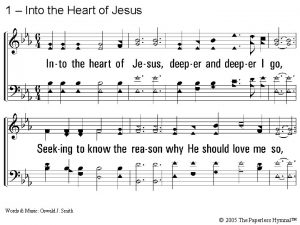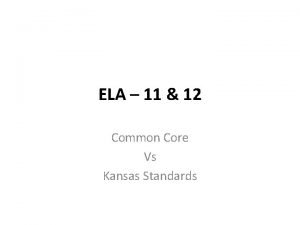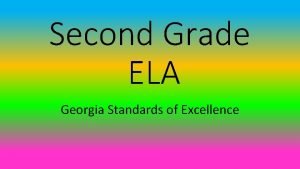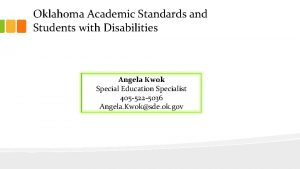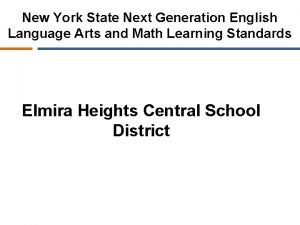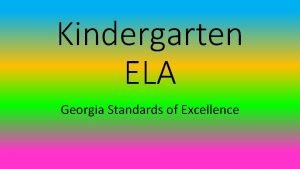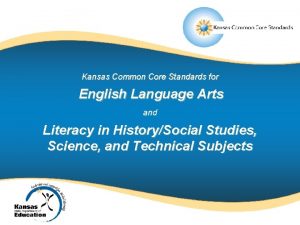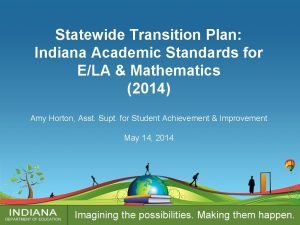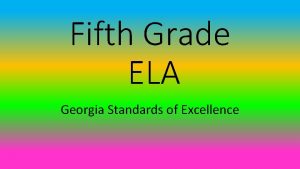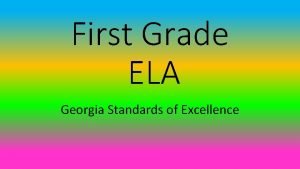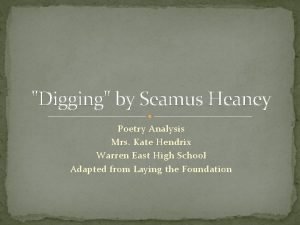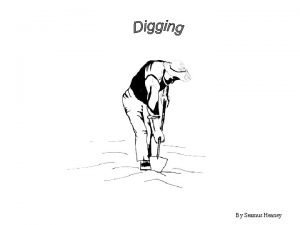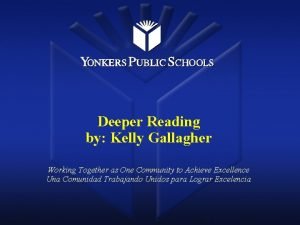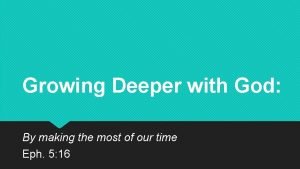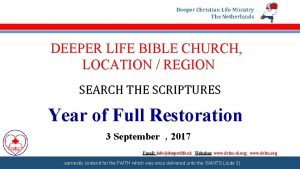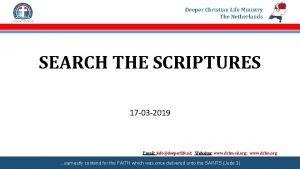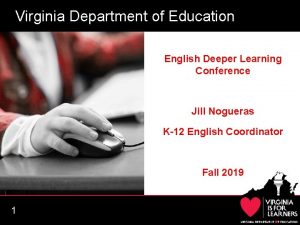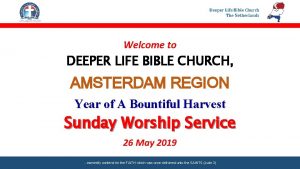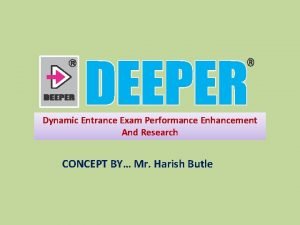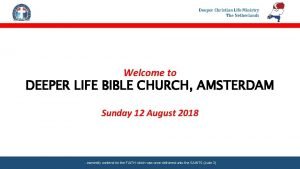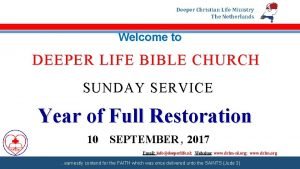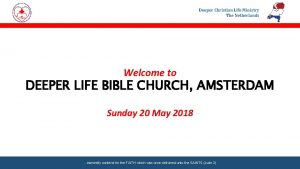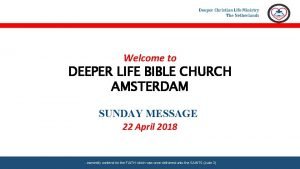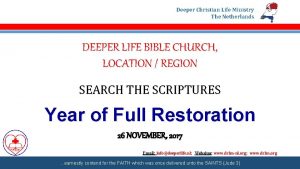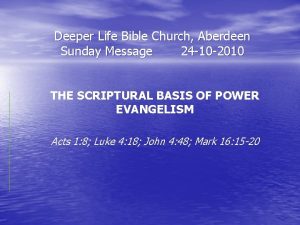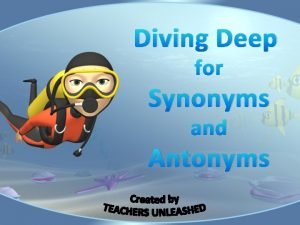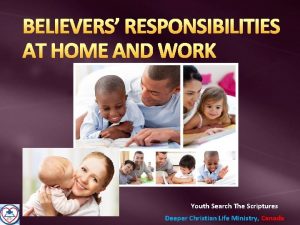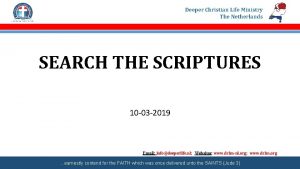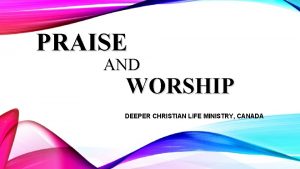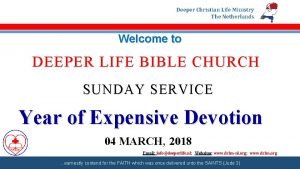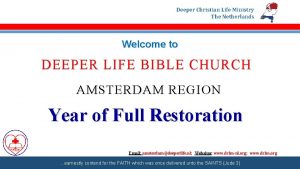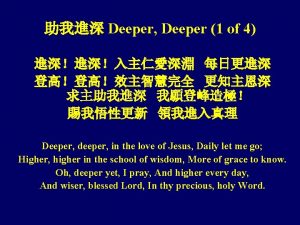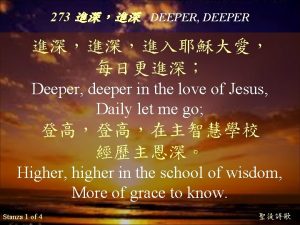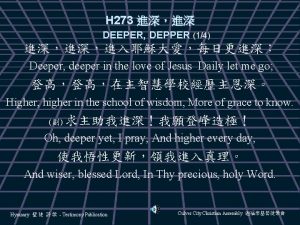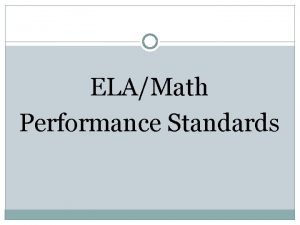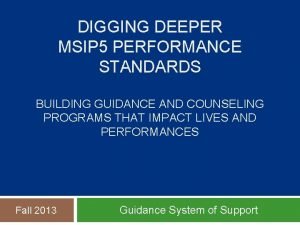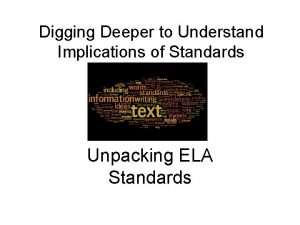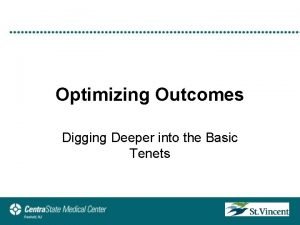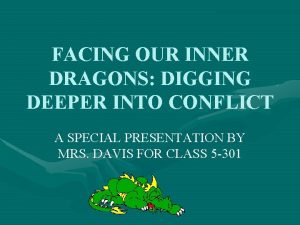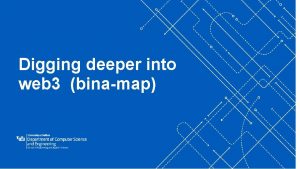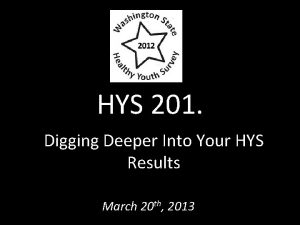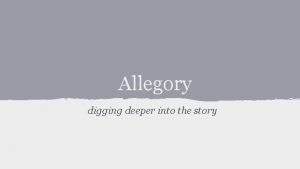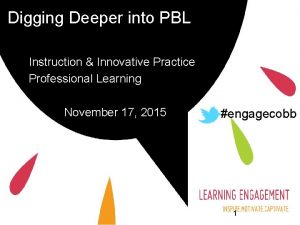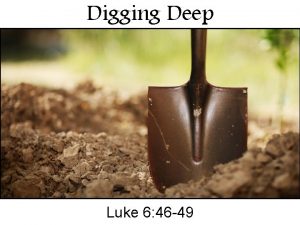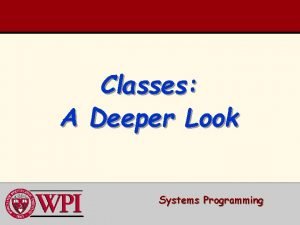Digging Deeper Into the K 5 ELA Standards

















































- Slides: 49

Digging Deeper Into the K 5 ELA Standards College and Career Ready Standards Implementation Team Quarterly – Session 2

Today’s Outcomes Participants will … • Gain a deeper understanding of the vertical alignment of grade level standards (K-5). • Gain a deeper understanding of how the key shifts support the implementation of the standards (K-5). • Clarify their understanding of what the standards look like in practice (K-5).

L A GO Strands

Why We Need Common Core • Video Clip ▫ http: //www. youtube. com/watch? v=d. Y 2 m. RM 4 i 6 t. Y

Speaking & Listening Languag e English Languag e Literacy Writing Readin g Foundationa l Skills (K- 5) Reading Literature Reading Informational Text

Foundational Skills

Reading: Foundational Skills Subcategories: • Print Concepts • Phonological Awareness • Phonics and Word Recognition • Fluency

Say Something Handout #1 1. Read each statement. 2. Jot your thinking. 3. “Say Something” about the text to your partner. 4. Repeat the process for each statement.

Reading: Foundational Skills Part A • Read the introductory paragraph on Handout #2. • Highlight important concepts covered in the paragraph regarding Foundational Skills (K-5). • Discuss the major concepts. • Complete the chart, Handout #3.

Reading: Foundational Skills Part B • Read the Foundational Skills standards for your grades. • Underline key words that show these standards are related. • Circle key words that show the expectation becomes more rigorous at each grade level. • Discuss your overall impressions about the Foundational Skills Standards. What are the implications for you?

Let’s Look at a Lesson Using Foundational Skills

Standard for This Lesson 20. Know and apply grade level phonics and word analysis skills in decoding words. b. Know spelling-sound correspondences for additional common vowel teams. RF. 2. 3 b

Insight Tool What procedural skill(s) does What could students do to What does the student need to the student show attainment of this to know to aid indemonstrate attainment for attainment of standard? of this standard?

Lesson Objectives Students will be able to read and spell words with the /ou/ sound spelled ou.

Planning for Instruction Considerations: • Provide multiple opportunities for students to practice reading words with the new sound-symbol correspondence. • Determine what needs to be done if a student is having difficulty.

Gradual Release of Responsibility Model = M Guided Practice = GP Collaborative Practice = CP Independent Practice = IP


Lesson Look Fors • Use the lesson plan tool to look for evidence that the lesson objective is being met.

Phonics Lesson

Was the Outcome Met? Students will be able to read and spell words with the /ou/ sound.


Lesson Standards 20. Know and apply grade level phonics and word analysis skills in decoding words. b. Know spelling-sound correspondences for additional common vowel teams. RF. 2. 3 b 21. Read with sufficient accuracy and fluency to support comprehension. b. Read on-level text orally with accuracy, appropriate rate, and expression on successive readings. c. Use context to confirm or self-correct word recognition and understanding, rereading as necessary. RF. 2. 4 36. Demonstrate command of the conventions of Standard English capitalization, punctuation, and

BREAK • Up Next: ▫ Review of Text Complexity and 3 Key Shifts

Why Informational Text? • Go to Handout 5 from Appendix A. • Find the starred paragraphs. • Read these three paragraphs to investigate and note the importance of informational text in the standards. • Write your “aha’s and questions” on Handout #6. • Think about and discuss examples you could use throughout the day, across the curriculum. • Jot examples on the chart.

Why We Need Common Core • http: //www. youtube. com/watch? v=yll 0 f. Jr. UAWE

Three Key Shifts in ELA/Literacy 1. Building knowledge through contentrich nonfiction and informational texts. 2. Reading, writing and speaking grounded in evidence from text, both literary and informational 3. Regular practice with complex text and its academic language

Informational Text subgenres expository text functional text argument literary nonfiction

Content-Rich Nonfiction IS. . . • informational text that gives factual information on a specific topic or event. • designed primarily to explain, explain argue or describe rather than to entertain.

A Balance of Text K-5 Informational Text Core Programs Science/SS Literature Short Stories Myths Legends Poetry Drama

A Balance of Text K-5 Informational Text Literature Biographies, History, Social Studies, Science, the arts, directions, forms, graphs, charts, maps, digital sources, etc. Short Stories Myths Legends Poetry Drama

Tracing the Standards for Reading Informational Text • Number off 1 -9. • Your number represents the standard you will trace.

32 Tracing the Standards for Reading Informational Text CCRS Reading Informational Text Standards K- 5

Let’s Look at a Lesson Using Informational Text

Classroom Structure • Third grade class during the reading block • Thirty minute small group lesson • Seventeen students in the class • Seven students are at the small group table • Mixture of middle to high level students • Two students in small group are identified as special needs • Ten students are working on activities from the weekly story and taking the selection test on the computer

Standard for This Lesson 19. By the end of the year, read and comprehend informational texts, including history/social studies, science and technical texts, at the high end of the grades 2 -3 text complexity band independently and proficiently. RI. 3. 10

Insight Tool Connection Insert screenshot of 3 rd R 1.

Planning for the Lesson Considerations: • Provide many opportunities for students to practice with complex text • Strong focus on academic language by using pictures, sentences, and examples/non-examples • Provide opportunities for students to answer questions by using details/evidence from the text

www. alex. state. al. us/isp

Lesson Look Fors • Use the ISP tool to look for evidence that the lesson objective is being met.

Informational Text Video • Video Clip

Evidence of using details text to explain reasoning: from the

Evidence of using details text to explain reasoning: from the

Were the Outcomes Met? Students will be able to do the following: • gather evidence to compare/contrast • ask questions • use details from the text to explain reasoning.

Lesson Standards 10. Ask and answer questions to demonstrate understanding of a text, referring explicitly to text as a basis for the answers. RI. 3. 1 13. Determine the meaning of general academic and domain specific words and phrases in a text relevant to Grade 3 topic or subject area. RI. 3. 4 16. Use information gained from illustrations and the words in a text to demonstrate understanding of the text. RI. 3. 7 19. By the end of the year, read and comprehend informational texts, including history/social studies, science and technical texts, at the high end of the grades 2 -3 text complexity band independently and proficiently. RI. 3. 10

Lesson Standards 31. Engage effectively in a range of collaborative discussions with diverse partners on grade 3 topics and texts building on others ideas and expressing their own clearly. SL. 3. 1 22. Write opinion pieces on topics or texts, supporting a point of view with reasons. W. 3. 1 37. Demonstrate command of the conventions of Standard English grammar and usage when writing or speaking. L. 3. 1

Classroom Snapshots When visiting a K– 5 classroom, You would see. . . • Time spent with informational texts. • A classroom filled with books on topics about insects, weather, energy, reptiles, the Civil War, geography, sports, and other topics that interest elementary grade children. • The use of thematically-paired story and informational texts or several informational texts grouped in a thematic unit. • Graphic organizers related to informational text and topics (e. g. , K–W–L charts, Venn Diagrams for comparing and contrasting, and semantic maps). • Explicit comprehension strategy instruction. • Explicit vocabulary instruction. • Writing to read and reading to write activities about

Classroom Snapshots When visiting a K– 5 classroom, You would see. . . • Teachers and students using a core set of questions that they ask each time they encounter informational text (e. g. , questions could be generic or topic-specific to guide student thinking and help them make sense of what they are reading). • A classroom configured to enable students to read, write, and talk collaboratively with partners about informational text and topics. • Teachers using ―precision partnering (e. g. , student partner discussions with a designated first speaker, use of sentence starters, accountable listening, and teacher monitoring). • Task-based accountability is built in for every lesson task/activity— there is clear accountability with every student doing every task (e. g. , students all required to say, write, and/or do something as an ―evidence check of engagement). • Teachers using engagement to structure discussions (e. g. , responding of all students, everyone does everything—no bystanders) versus structuring discussions using traditional handraising (i. e. , teacher poses a questions and students raise their

Classroom Snapshots When visiting a K– 5 classroom, You would hear. . . • Language! Talk! Instructional conversations! (Beck & Mc. Keown, 2001; 2007 a; Palinscasar & Duke, 2004; Saunders & Goldenberg, 1999; Goldenberg, 1992/1993). Teacher and students talk about informational text and topics. • Questions! Teacher and student-initiated questions about the informational text. • Vocabulary! Teachers and students using content vocabulary (e. g. , habitat and molt) from or about the informational text. • Academic Language! Teachers and students using textrelated academic language (e. g. , table of contents, index, informational book, and retell) from or about the informational text. • Teacher-facilitated read-alouds and text-based discussions (Santoro et al. , 2008).

Reflection What are the implications for you/your work based on your learning about foundational skills AND informational text?
 Into the heart of jesus deeper and deeper i go
Into the heart of jesus deeper and deeper i go Civil war digging deeper webquest answers
Civil war digging deeper webquest answers Kansas ela standards
Kansas ela standards Georgia reading standards 2nd grade
Georgia reading standards 2nd grade Oklahoma state standards ela
Oklahoma state standards ela Nys ela standards
Nys ela standards Kindergarten standards georgia
Kindergarten standards georgia Ksde ela standards
Ksde ela standards Indiana ela standards
Indiana ela standards Georgia kindergarten reading standards
Georgia kindergarten reading standards First grade reading standards georgia
First grade reading standards georgia Digging by seamus heaney analysis
Digging by seamus heaney analysis Digging in between
Digging in between Bones used in volleyball
Bones used in volleyball Factors necessary for appropriate service standards
Factors necessary for appropriate service standards Deeper reading kelly gallagher
Deeper reading kelly gallagher Growing deeper in god
Growing deeper in god Deeper life netherlands
Deeper life netherlands Deeper life netherlands
Deeper life netherlands Your love is deeper than the ocean higher than the heavens
Your love is deeper than the ocean higher than the heavens Deeper learning conference
Deeper learning conference Deeper life bible church netherlands
Deeper life bible church netherlands Deeper life netherlands
Deeper life netherlands Deeper life bible church netherlands
Deeper life bible church netherlands Deeper life bible church netherlands
Deeper life bible church netherlands Deeper
Deeper Deeper life bible church netherlands search the scriptures
Deeper life bible church netherlands search the scriptures Deeperph
Deeperph Deeper life bible church
Deeper life bible church Deeper life bible church netherlands search the scriptures
Deeper life bible church netherlands search the scriptures Deeper life netherlands
Deeper life netherlands Deeper life netherlands
Deeper life netherlands Deeper life netherlands
Deeper life netherlands Deeper life sunday message
Deeper life sunday message Deeper life bible church netherlands search the scriptures
Deeper life bible church netherlands search the scriptures Dive deep synonyms
Dive deep synonyms Search the scriptures netherlands
Search the scriptures netherlands Deeper life bible church netherlands
Deeper life bible church netherlands Deeper life netherlands
Deeper life netherlands Deeper life canada
Deeper life canada Dclm netherlands
Dclm netherlands Deeper life netherlands
Deeper life netherlands Go deeper in christ
Go deeper in christ Deeper life netherlands
Deeper life netherlands Diễn thế sinh thái là
Diễn thế sinh thái là V. c c
V. c c Từ ngữ thể hiện lòng nhân hậu
Từ ngữ thể hiện lòng nhân hậu 101012 bằng
101012 bằng Thơ thất ngôn tứ tuyệt đường luật
Thơ thất ngôn tứ tuyệt đường luật Tư thế ngồi viết
Tư thế ngồi viết
